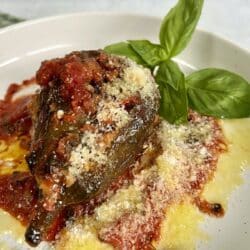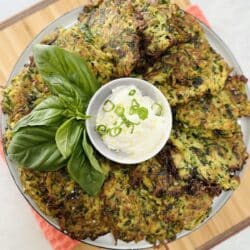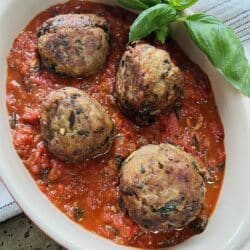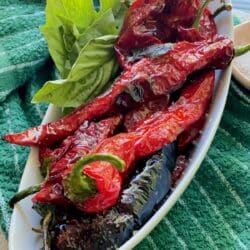
This post may contain affiliate links or sponsored content. That means if you click on my link and buy something, I will earn a small commission from the advertiser at no additional cost to you. For more information on this, please click here.
Eggplant Milanese, otherwise known as Italian Fried Eggplant Cutlets, is crispy on the outside, tender on the inside, and full of flavor! Thin slices of eggplant are dipped in egg, then a homemade, cheesy, seasoned breadcrumb mixture, then fried gently until crispy. Your whole family will love this iconic Italian-American eggplant dish.

Eggplants have a deep, earthy flavor and meaty texture that makes them so versatile to work with. I love how they are great grilled, roasted, pickled, pureed in soups and dips, stuffed, mashed into meatless “meatballs”, or fried as in this recipe. Any way you prepare eggplant, it always seems to deliver on both flavor and texture. It’s also very satisfying.
Eggplant Milanese is classic Italian-American fare. Think of it as the vegetarian version of beloved chicken or veal cutlets. You can serve these eggplant cutlets as an appetizer, side dish or even a vegetarian entrée. They can also double as a building block for other, more involved, recipes, such as eggplant parm or rollatini.
With only a few, significant ingredients, this recipe is mostly about ingredient quality and technique. Making the seasoned breadcrumbs yourself makes all the difference here! Keep reading for more information about the ingredients in this dish.
What Inspired This Recipe
I have been eating Eggplant Milanese my whole life. Maybe because the eggplant is one of the cornerstone ingredients of classic Sicilian cuisine and my maternal grandparents were Sicilian immigrants. Maybe because my Aunt Mary always brought my mom lots of eggplant from her farm in south Jersey that we needed to use up. Or maybe because everyone in my family just freakin’ loved it!
And, although we didn’t call these guys Milanese growing up (we just called them fried eggplants), this term is apropos given that they are like an eggplant adaptation of one of Milan’s most iconic recipes, cotoletta alla milanese (a.k.a., veal Milanese or veal cutlet).
There’s not much to not love about eggplant, in my humble opinion, especially when it is thinly sliced, coated with a super-flavorful breading, and fried until crispy. My mom was the queen of making the most perfectly fried, thinly sliced eggplant cutlets. And, she never stopped being amazed at how many cutlets she would get out of every eggplant. (The exact opposite of what happens when you cook a bushelful of greens . . .) To this day, I can still hear her saying in amazement after every batch that she made, “Can you believe this was only one eggplant?”. And, I still smile thinking about it.

Why You’ll Love This Recipe
- Very Versatile: There are so many ways that you can serve Eggplant Milanese. From turning it into eggplant parm or rollatini, to making it the star of a vegetarian sandwich, or to adding it to an antipasto platter or caprese salad, you’ll be amazed at the many ways that you can enjoy this dish.
- Flexible Recipe: You can fry or bake the breaded eggplant cutlets, based on your preference. I have provided information for both methods in the recipe.
- Great for Meal Prep! Make a big batch of these cutlets and enjoy them throughout the week. They’ll hold up to five days in the refrigerator or up to three months in the freezer in an airtight container. It’s a great way to have something delicious ready in a pinch!

Ingredients for Eggplant Milanese
This recipe has few ingredients, but they are all significant. Like a simple fried chicken cutlet or fried peppers, it relies on simple technique and great seasoning to become delicious. Here are the ingredients we will be using:
- Eggplant: Almost any variety of eggplant can be used successfully in this recipe. I almost always use the large globe (a.k.a., American) eggplant because it is the most widely available year-round. But, I actually prefer the round Sicilian eggplant and will use that if I can find it. When selecting eggplant, look for a plump, slightly firm, but not hard, texture and choose an eggplant that is shiny and feels heavy for its size, as lightweight eggplants generally reflect an excess of seeds. Smaller is preferable as they tend to be young and not bitter. Check out this link for some interesting information about all the different varieties of eggplant out there!
- Breadcrumbs, Pecorino Cheese, Dried Herbs and Spices: With so few ingredients in this recipe, the quality of each item is very important. And, one of the main reasons why these pan-fried Eggplant Cutlets are so delicious is the homemade seasoned breadcrumbs. (And, the cheese, which makes the breading more crunchy and tasty.) Try not to be tempted to purchase already seasoned breadcrumbs that have been sitting on a grocery shelf for who knows how long. While I admit that I rarely make the actual fine breadcrumbs themselves from scratch (my food processor doesn’t seem to be strong enough), I always purchase fine breadcrumbs from a local bakery and then turn them into homemade seasoned breadcrumbs. It’s so easy and can be made with ingredients that you probably already have on hand. Once you make your own, you will likely never go back to store-bought! My main advice–use good quality spices and dried herbs. If they have been in your cupboard for several years and look sketchy–replace them! Having said all this, you can, of course, use store-bought seasoned breadcrumbs rather than make them from scratch.
- Eggs and Milk: The role of eggs in this recipe is to act as a binder during the breading process and give the breadcrumbs something to hold onto. The milk adds moisture and a bit of richness.
- Oil: Use either a pure or virgin olive oil or a neutral oil with a high smoke point, such as avocado oil or a vegetable oil, for the pan-frying. You can certainly use extra-virgin olive oil for the frying, but it is not necessary.
A complete and detailed list of ingredients with amounts and instructions is included in the recipe below.

How to Make Eggplant Milanese, Step-by-Step
Here are the main steps for making these breaded and fried, Italian eggplant cutlets:
- Prep and gather all ingredients. Then, make the seasoned breadcrumbs by mixing all the breadcrumb ingredients together in a large bowl until well-combined.
- PRO-TIP: Try not to be tempted to purchase already seasoned breadcrumbs that have been sitting on a grocery shelf for who knows how long. Once you make your own, you will likely never go back to store-bought! My main advice–use good quality spices and dried herbs. If they have been in your cupboard for several years and look sketchy–replace them!


- Cut off the thick stem of the eggplant and peel it. Then, carefully cut the eggplant into slices that are about 3/8” thick.

- Whisk the eggs and milk together in a large bowl until well-combined. Then, set up a breading station as follows: pile of raw, sliced eggplant, then a shallow bowl of egg mixture, then a shallow bowl of seasoned breadcrumbs, then a baking sheet.
- PRO-TIP: This method is actually not a classic breading procedure that starts out with flour before the egg. I’ve tried it both ways and prefer omitting the flour. The breading becomes a bit too thick with the flour added.


- Coat each slice of eggplant fully in the egg mixture, then transfer it to the breadcrumbs and fully coat it, patting it if necessary to ensure that the breadcrumbs adhere, then place the breaded eggplant on a sheet pan. Continue doing this for all the eggplant slices.
- PRO-TIP: If you are using your hands for this, use one hand for the wet egg mixture and the other for the dry breadcrumb mixture to keep things neater and more streamlined.
- PRO-TIP: The amount of egg/milk and breadcrumb mixtures that you will need will vary based on how thinly or thickly you slice your eggplant. The thinner you slice them, the more surface area that there is to coat and the more of each mixture that you will need. And, it’s the opposite with thicker slices. I prefer thinner slices because they are crispier, more versatile in different dishes, and so much more fun to eat!


- Add enough oil to a large skillet to cover the bottom of the pan by about ½”. Heat the oil over medium heat until bubbles form around a wooden spoon inserted in the oil.
- PRO-TIP: If the breaded eggplant is placed in the pan before the oil is hot enough, it will absorb too much oil and become soggy.
- Gently shake off any excess breadcrumbs from each piece of breaded eggplant. Then transfer each piece to the hot oil, one at a time, making sure to not crowd the pan or pile the eggplant on. Fry a few pieces at a time–only as many as will fit in one layer.
- PRO-TIP: You may have extra seasoned breadcrumbs left over. Hold them for several weeks in the refrigerator in an airtight bag or container. If you use seasoned breadcrumbs frequently, I suggest making a double or triple batch and then you will have them whenever you need.


- Fry until the eggplant is golden brown on one side, then turn it over and do the same on the other side. This will take about 2 to 3 minutes per side. You will need to work in batches and may need to add additional oil during the frying process.
- PRO-TIP: Use a splatter screen to reduce oil from messing up your workspace!
- PRO-TIP: If you have made a double batch and/or have been frying for awhile, the oil will likely become cloudy and sludgy from all of the residual breadcrumbs and seasonings that have fallen off the eggplant and have burnt. Use your judgment, but, at some point, you may need to clean the pan and start with a fresh amount of oil. Alternatively, you can let the oil cool completely, and then drain it through a sieve lined with cheesecloth or a coffee filter into a clean container. By doing this, you can reuse the oil.
- Once browned and finished, transfer the fried eggplant slices to a rack placed over a sheet pan. This will help the eggplant cutlets to maintain their crispiness rather than placing them on a paper towel. Sprinkle the fried eggplant very lightly with some salt, if desired.


- Then, they are ready to eat! In fact, I would be surprised if you didn’t eat the first one that was ready–they are so good! Serve them as is or use them in any number of ways. See Serving Suggestions below for some great ideas. Buon Appetito!
- PRO-TIP:To store, refrigerate the breaded fried eggplant in an airtight container for up to 5 days or freeze them in an airtight freezer container for up to 3 months. The eggplant will lose is crispiness once refrigerated or frozen, but will still be delicious.

More Delicious Eggplant Recipes
If you are looking for more recipes with eggplant, check these out:
- Sicilian Eggplant Meatballs–a meatless option your whole family will love
- “Buttoned Up” Sicilian Stuffed Melanzane–a unique, stuffed Italian eggplant braised in tomato sauce
- Roasted Vegetable Caponata without Tomatoes–a twist on the classic!
- Bucatini with Ricotta and Slow-Roasted Eggplant and Tomatoes–the flavors of summer
- Roasted Baby Eggplant with Crispy Garlic and Herbs–simple and delicious!
Frequently Asked Questions about Eggplant Milanese
Here are answers to some frequently asked questions about making this recipe:
Almost any variety of eggplant can be used successfully in this recipe. I almost always use the large globe (a.k.a., American) eggplant because it is the most widely available year-round. But, I actually prefer the round Sicilian eggplant and will use that if I can find it.
When selecting eggplant, look for a slightly firm, but not hard, texture and choose an eggplant that feels heavy for its size. The eggplant is too far gone if you can puncture its skin.
Leaving the skin on eggplant is a personal choice. While eggplant skin is edible and nutrient-rich, I find it tough and sometimes bitter. If you leave the skin on for this recipe and slice the eggplant thinly as recommended, you most likely will not even notice it.
Unless you are using old eggplant that have been stored for too long, no, you do not need to salt the eggplant. I realize this may be a controversial standpoint, since so many people swear by salting eggplants to remove its bitterness. The reality is that, over the years, farmers have bred out much of eggplants’ signature bitterness, rendering salting unnecessary. Having said this, click here for great information about salting eggplants.
Yes, but recognize that the result will be a bit different. Panko is made from a crustless white bread that is processed into flakes and then dried. They have a dryer and flakier consistency than regular breadcrumbs and result in lighter and crunchier fried food. Regular breadcrumbs are processed into a finer crumb than panko and are not as dry and flaky as panko. They have more of a bread-like consistency when fried.
If you would like to substitute panko for regular (fine) breadcumbs, a 1:1 substitution usually does the trick.
In my experience, salt added to either an egg mixture or breadcrumb mixture for frying any type of cutlet always ends up sinking to the bottom of the mixture and never makes it on to the eggplant/chicken/veal, etc. So, I don’t add it at the beginning of the cooking process. Rather, I salt the cutlets lightly once they come out of the frying pan. Much better!
Use either a pure or virgin olive oil or a neutral oil with a high smoke point, such as avocado or vegetable oil, for the pan-frying. You can certainly use extra-virgin olive oil for the frying, but it is not necessary.
Yes, to cut down on the amount of oil, you can bake these eggplant cutlets instead of frying them. To do this, spray a parchment-lined sheet pan lightly with oil, then arrange the breaded eggplant in a single layer on the parchment. Spray the tops of the cutlets with a little oil, then place in a 375°F oven for approximately 10 minutes. Turn over all the cutlets, then continuing baking until the eggplant flesh is soft and the outside is crispy, another 10 minutes or so. The baked cutlets will likely not have the same golden brown/fried look. Depending on how you are going to use them, baking the eggplant cutlets is a great option. For example, they work really well when layered with sauce and cheese for a baked eggplant parmesan.

Serving Suggestions and Storage
Eggplant Cutlets have so much potential beyond Eggplant Parm! Once you think of them like chicken cutlets, you’ll realize all the great ways that you can use them in different dishes.
Frankly, I’d be happy to cozy up with a plateful of them with some marinara dipping sauce and a glass of red wine and call it dinner. Having said this, here are a few of my other favorite ways to enjoy them:
- Similar to a traditional chicken Milanese–topped with a simple arugula salad with lemon, extra virgin olive oil, shaved parmigiano cheese and a few cherry tomatoes thrown in for good measure.
- Added to a platter of insalata caprese. (See photo above!)
- Layered in a baking dish or on a roll with tomato basil sauce, mozzarella and parmesan cheese for a classic Italian American eggplant parmigiana or eggplant parm hero.
- As a delicious and unique addition to an antipasto platter, paired with cured meats, cheeses, olives, roasted peppers and more! (See photo below.)
- Spread with some ricotta cheese, rolled up and baked with tomato sauce and mozzarella for a traditional eggplant rollatini.
- As an accompaniment to any number of hearty entrees or pastas, such as:
- Make an Eggplant Milanese sandwich! Frankly, I just love making eggplant cutlets the star of a hearty vegetarian sandwich with some sautéed broccoli rabe, roasted peppers and either sharp provolone or fresh mozzarella cheese. Alternatively, it’s also amazing added to a meatier chicken or meatball parm hero.
- Or, as a simple side to a larger entrée salad, such as a Greek, Caesar or Cobb salad.
To store, refrigerate the breaded fried eggplant in an airtight container for up to 5 days or freeze them in an airtight freezer container for up to 3 months. The eggplant will lose is crispiness once refrigerated or frozen, but will still be delicious.
To reheat the milanese cutlets and crisp them up, place them in an oven proof baking dish or on a sheet pan and bake at 350° for 10 to 12 minutes or until crispy and heated.

Recipe Variations and Substitutions
Here are a few ways to modify this recipe:
- Make it Gluten-Free: Swap out the regular breadcrumbs for gluten-free breadcrumbs.
- Make it Dairy-Free: You can leave the grated cheese out of the seasoned breadcrumbs and still have a delicious cutlet! If you would like, try substituting the cheese with about ¼ cup nutritional yeast for some additional flavor.
- Roast instead of Fry: To cut down on the amount of oil, you can make a baked eggplant Milanese instead of fried. To do this, spray a parchment-lined sheet pan lightly with oil, then arrange the breaded eggplant in a single layer on the parchment. Spray the tops of the cutlets with a little oil, then place in a 375°F oven for approximately 10 minutes. Turn over all the cutlets, then continuing baking until the eggplant flesh is soft and the outside is crispy, another 10 minutes or so. The baked cutlets will likely not have the same brown/fried look. Depending on how you are going to use them, baking the eggplant cutlets is a great option. For example, they work really well when layered with sauce and cheese for a baked eggplant parmesan.
- Make them Handy: Make a more, handy, finger food-like version in large cubes or long, thick slices like steak fries instead of thin slices. Serve it as an hors d’oeuvre with some ranch or Caesar dressing (like a better and bigger version of a chicken nugget!).

If you like this recipe, check out Easy Turkey Meatballs with Pesto, Stuffed Italian Peppers, Fried Italian Peppers, and Pasta with Quick Grape Tomato Sauce.
Kitchen Tools & Cookware Needed
To make Eggplant Milanese, you’ll need the following:
- Cutting board with non-slip mat underneath (I use shelf liner)
- Sharp chef’s knife
- Measuring cups and spoons
- Multiple bowls to hold prep
- Tongs
- Sheet pan with rack
- Frying pan
- Splatter screen
- Serving platter
- Serving utensils

More Great Recipes to Try
I hope that you are enjoying my Italian food blog and all of my Italian recipes and Italian-American recipes!
If you’ve tried this or any recipe on the blog, please let me know how it went in the comments. I love hearing from you!
FOLLOW ME on FACEBOOK and INSTAGRAM to see more delicious food and what might be going on behind the scenes!

Eggplant Milanese ~ Italian Fried Eggplant Cutlets
Ingredients
- 2 pounds eggplant (approximately)
- 3 large eggs
- ¼ cup whole milk
- 3 cups Seasoned Breadcrumbs (See below.)
- Olive or other oil as needed for frying (See Note.)
- Salt, for finishing
For Seasoned Breadcrumbs:
- 2 cups plain breadcrumbs (fine texture)
- 1 cup grated Pecorino Romano cheese
- 2 Tbsp dried oregano
- 2 Tbsp dried basil
- 2 Tbsp garlic powder
- 2 Tbsp onion powder
- 2 tsp ground black pepper
Instructions
- Prep and gather all ingredients according to specifications above. Then, make the seasoned breadcrumbs by mixing all the breadcrumb ingredients together in a large bowl until well-combined. These can be made several hours or days in advance and held in the refrigerator in an airtight bag or container.2 cups plain breadcrumbs, 1 cup grated Pecorino Romano cheese, 2 Tbsp dried oregano, 2 Tbsp dried basil, 2 Tbsp garlic powder, 2 Tbsp onion powder, 2 tsp ground black pepper
- Cut off the thick stem of the eggplant and peel it. Then, carefully cut the eggplant into slices that are about ⅜” thick.2 pounds eggplant
- Whisk the eggs and milk together in a large bowl until well-combined.3 large eggs, ¼ cup whole milk
- Then, set up a breading station by arranging the following in a row: pile of raw, sliced eggplant, then bowl of egg mixture, then bowl of seasoned breadcrumbs, then a sheet pan. Using either your hand or a fork/tongs, coat each slice of eggplant fully in the egg mixture, then transfer it to the breadcrumbs and fully coat it, patting it if necessary to ensure that the breadcrumbs adhere, then place the breaded eggplant on a sheet pan. Continue doing this for all the eggplant slices. (Note: If you are using your hands for this, use one hand for the wet egg mixture and the other for the dry breadcrumb mixture to keep things neater and more streamlined.)3 cups Seasoned Breadcrumbs
- Meanwhile, add enough oil to a large skillet to cover the bottom of the pan by about ½”. Heat the oil over medium heat until bubbles form around a wooden spoon inserted in the oil. Note that if the breaded eggplant is placed in the pan before the oil is hot enough, it will absorb too much oil and become soggy.
- Gently shake off any excess breadcrumbs from each piece of breaded eggplant. Then transfer each piece to the hot oil, one at a time, making sure to not crowd the pan or pile the eggplant on. Fry a few pieces at a time–only as many as will fit in one layer. Fry until the eggplant is golden brown on one side, then turn it over and do the same on the other side. This will take about 2 to 3 minutes per side. You will need to work in batches and may need to add additional oil during the frying process.
- Once browned and finished, transfer the fried eggplant slices to a rack placed over a sheet pan. This will help the eggplant cutlets to maintain their crispiness rather than placing them on a paper towel. Sprinkle the fried eggplant very lightly with some salt, if desired. Then, they are ready to eat! In fact, I would be surprised if you didn’t try the first one that was ready–they are so good! Serve them as is or use them in any number of ways. See Serving Suggestions above for some great ideas. Buon Appetito!
Notes
- You may have extra seasoned breadcrumbs left over. They can be held for several weeks in the refrigerator in an airtight bag or container. If you use seasoned breadcrumbs frequently, I suggest making a double or triple batch and then you’ll have them whenever you need.
- The amount of egg/milk and breadcrumb mixtures is an approximation and will vary based on how thinly or thickly you slice your eggplant. The thinner you slice them, the more surface area that there is to coat and the more of each mixture that you will need. And, it’s the opposite with thicker slices. I prefer thinner slices because they are crispier, more versatile in different dishes, and so much more fun to eat!
- Use either a pure or virgin olive oil or a neutral oil with a high smoke point, such as avocado oil, (or a combination thereof) for the pan-frying. You can certainly use extra-virgin olive oil for the frying, but it is not necessary.
- If you have made a double batch and/or have been frying for awhile, the oil will likely become cloudy and sludgy from all of the residual breadcrumbs and seasonings that have fallen off the eggplant and have burnt. Use your judgment, but, at some point, you may need to clean the pan and start with a fresh amount of oil. Alternatively, you can let the oil cool completely, and then drain it through a sieve lined with cheesecloth or a coffee filter into a clean container. By doing this, you can reuse the oil.
- To store, refrigerate the breaded fried eggplant in an airtight container for up to 5 days or freeze them in an airtight freezer container for up to 3 months. The eggplant will lose is crispiness once refrigerated or frozen, but will still be delicious.
- To reheat the milanese cutlets and crisp them up, place them in an oven proof baking dish or on a sheet pan and bake at 350° for 10 to 12 minutes or until crispy and heated.








Finally succeeded growing eggplant in our backyard. Perfect for this recipe – they were delicious! I was forced to eat them all as no one else in the house likes eggplant. Yummy! ❤️🍆
So glad you enjoyed the recipe, Barbara!
This recipe was perfect! Just like my mom used to make. Thank you.
So glad that you liked it. Thank you for the comment, Maria.